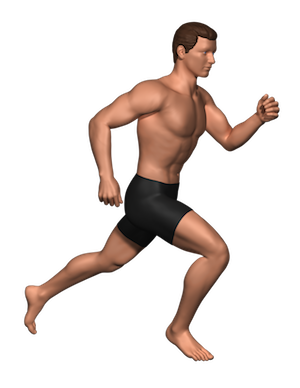Arm and wrist pain may be due to herniated discs in the neck irritating the spinal nerves, trigger points which are a hyperirritable spot within a skeletal muscle that can refer pain to a specific region, tennis elbow, golfer’s elbow and carpal tunnel syndrome.
Let’s look more closely at these causes:
Tennis Elbow (Lateral Epicondylitis)
This is usually an overuse syndrome of the muscles that extend your wrist. It is really a tendinitis. As we get older, it can become a degenerative form of tendinitis called tendinosis. The involved muscle group is located on the thumb side of the forearm near the elbow. It is called tennis elbow but only 5% of patients relate the injury to tennis. It occurs more commonly in repetitive motions like computer work, carpentry, heavy lifting as well as gardening. Sports like baseball and swimming may lead to problems in that area. Tennis elbow is about 5 times more common than golfer’s elbow (Medial Epicondylitis). Symptoms are weakness and pain with gripping and extending the wrist, especially against resistance. Pressure on the affected region can be excruciating. Chiropractic management is evaluation from the mid cervical (neck) to the upper thoracic (mid back) regions for subluxations, evaluate the elbow joint for proper alignment, muscle work and stretching.
Arm and Wrist Trigger Points (TP’s)
Again, these are hyperirritable focal spots within a skeletal muscle that refers pain to a specific region. Several examples are TP’s in the Supraspinatus muscle of the rotator cuff that can refer pain and tingling to the lateral arm to the elbow, TP’s in the Infraspinatus muscle of the rotator cuff can refer pain and tingling to the front of the shoulder and the fingers and TP’s in the Subscapularis muscle of the rotator cuff can refer pain and tingling into the wrist. Chiropractic care involves removal of subluxations in the mid to lower neck region, TP muscle work and specific stretching to the involved muscles.
Arm and Wrist Herniated Disc
Spinal discs lie between two vertebrae with the lowest disc lying between the spine and the sacrum. Anatomically, discs have an outer layer called the annulus fibrosis. It is made up of fibrocatrilage which is the strongest type of cartilage in the body. Its purpose is to withstand compression which it does very well. If a healthy disc is sufficiently compressed between two vertebrae, the vertebrae will fracture before the disc will rupture. The inside of the disc is called the nucleus pulposus which is made of glycosaminoglycans (GAG). It functions to act like a shock absorber/ ball bearing and to absorb water; up to 9 times its own weight. Injuries to the discs of the cervical spine (neck) are very common. When a disc herniates, it usually goes straight back, to the left or to the right. These herniations can put pressure on the nerves coming out of the spine. Because the nerves in the neck travel down the arms all the way to the fingers, patients may experience pain, numbness or tingling down the arms. Many people present for chiropractic as a last resort for relief of disc problems. Many are happy they did.
Carpal Tunnel Syndrome
This is a common condition affecting approximately 5% of the population. The carpal tunnel is on the palm aspect of the wrist where 9 flexor tendons and the Median nerve pass through. The carpal tunnel is covered by the flexor retinaculum which is a ligamentous band that helps hold the ligaments is place. As you can see, it is a pretty congested tunnel. Causes can be repetitive motions of the wrist as in computer work, haircutting, cleaning, sowing, dentistry, athletics, cooking and electrical work. Excessive stretching of the wrist flexor muscles may contribute to this condition. Symptoms include numbness and tingling into the thumb, index, middle and half of the ring finger, hand clumsiness as in holding glasses or mugs, hand pain at night and hand weakness. Chiropractic care is focused on evaluation of the mid cervical to upper thoracic region for subluxations, evaluate the wrist joint for proper alignment, reduce adhesions in the wrist and stretching. Vitamin supplementation seems to be of benefit also.
Golfer’s /Pitcher’s Elbow (Medial Epicondylitis)
This is again usually an overuse syndrome but this time of the muscles that flex your wrist. It is again really a tendinitis that can become a degenerative tendinosis as we get older. The involved muscle group is locates on the pinky side of the forearm near the elbow. It is usually the result of incorrect or too tight a grip on the golf club and repetitive hard throwing or pitching. It is not confined to just these sports though. Weight lifting, painting, hammering and gardening are also culprits. Symptoms are weakness and pain with gripping, shaking hands, turning doorknobs and flexing the wrist especially against resistance. Chiropractic management is evaluation from the mid cervical to upper thoracic region for subluxations, evaluate the elbow joint for proper alignment, muscle work and stretching.
Fun Fact
When you bang your “funny bone”, you are striking the ulnar nerve which passes in a groove between the humerus (arm bone) and the ulna (forearm) bone at the elbow. The electric shock-like sensation is anything but funny.
Disclaimer
Chiropractors, like other doctors, cannot diagnose or treat patients without examining them in person. The information provided on this site is for general educational purposes only. If you are concerned about actual symptoms or complaints, consult with your own chiropractor.

